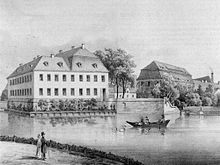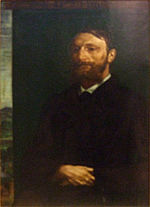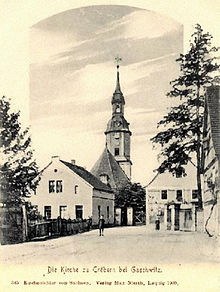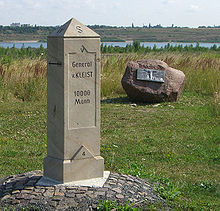Crawling
Cröbern was a village south of Leipzig . Administratively it belonged to the Leipzig-Land district in the Leipzig district . Since 1923 the neighboring village and manor Crostewitz belonged to Cröbern. Between 1967 and 1982 the entire village had to give way to lignite mining and was dredged over by the Espenhain open-cast mine . The corridor of both places has belonged to Markkleeberg since 1973 .
location
Cröbern was about ten kilometers south of Leipzig city center and two and a half kilometers south of Markkleeberg-Ost . The old town center, designed as a dead end village, rose on a gently rising hill to the right of the Gösel stream , a tributary of the Pleiße, which ran in a wide meadow valley . In the Middle Ages, the old trade route Via Imperii from Leipzig to Nuremberg ran through Cröbern and later the Poststrasse on the same route, which however lost its importance with the construction of the trunk road via Magdeborn (later F95).
Between Cröbern and Markkleeberg-Ost, but about 400 meters west of their connecting road and also on the Gösel, was the incorporated district of Crostewitz, a lane village with manor. The wild Mark Getzelau lay in his hallway .
The neighboring towns of Cröbern were Markkleeberg, Wachau , Güldengossa , Magdeborn, Zehmen , Großdeuben and Gaschwitz in a clockwise direction from the north .
history
The manor Crostewitz
In a treatise on the manor Crostewitz from 1860, it is assumed that war-tried fighters around the year 1000 were deployed in the Gau Chutizi as overseers of the Slavic villages. These fortified their property, which is also said to have led to the Crostewitz manor.
Crostewitz was first mentioned in 1285 as a manor, at the end of the 15th century as a knight's seat and in 1551 as a manor . The name developed from Kroznewitz (1285) to Krossenwicz (1350), Krostewicz (1451), Crostwitz (1488) and Croßwitz (1526) to Crostewitz (1753). The first owners of the manor known by name were the Lords of Zehmen . Via the lords of Mordeisen and Turk von Krostewitz, it came into the possession of the von Breitenbuch family in 1612 , from whom it was acquired by Johann Jakob Pantzer (epitaph in the former Leipzig University Church) in 1651, who sold it to Rupert Sulzberger in 1673. From 1725 it belonged to Peter Hohmann Edler von Hohenthal , who inherited it for two generations. About the Meinert brothers, factory owners from Oelsnitz / Erzgeb. (1834) it came into the possession of the Fiedler family, also from Oelsnitz / Erzgeb., Who kept it until 1945.
After the death of Hermann Fiedler (1811–1854), who had acquired the fortune to buy the estate in the textile industry, his widow initially ran the estate until his son Philipp Fiedler took it over. He and his brother Konrad Fiedler were both art-loving. Philipp wrote poetry and Konrad was one of the most important German art theorists of the 19th century and a patron of art . During this time, Crostewitz developed into a center of aesthetics where artists of all genres frequented. For example, the painter Hans von Marées stayed and worked for some time in Crostewitz at the invitation of Konrad Fiedler.
The last owner of Crostewitz was Philipp's son Dr. Martin Fiedler. He and his younger brother Wolfgang were driven from the estate penniless after the expropriation by the land reform in 1945 . The baroque mansion was demolished without any saving of art and used as building material for new farmhouses. The Gutsteich was designated as a garbage dump and thus destroyed an attractive landscape.
The villages of Cröbern and Crostewitz
Cröbern was first mentioned as Krobere in 1350. The name changed from Krober (1468) and Gröbern (1580) to Cröbern (1791). In 1551 there are 23 farm owners in Cröbern and 24 in 1764. For Crostewitz these numbers are 27 and 9. Although Cröbern 1445 is referred to as a knight's seat, from 1497 there was only one Vorwerk in the village and the village belonged to Crostewitz or Markkleeberg.
But the church in Cröbern stood for that. It was inaugurated in its last form in 1755. The collature of the church and school of Cröbern, whose teachers can be traced back to the middle of the 17th century, belonged to the manor Crostewitz. Crostewitz and the Vorwerk Auenhain, one and a half kilometers east of Crostewitz, were part of the parish of Cröbern . From an administrative point of view, the Vorwerk Auenhain belonged to Cröbern until 1922, before it moved to Wachau. Instead, Crostewitz came to Cröbern in 1923. Cröbern and Crostewitz with the desolate Mark Getzelau were in the electoral and royal Saxon district offices of Leipzig until 1856 . From 1856 both places belonged to the Leipzig II court office and from 1875 to the Leipzig district administration .
The days of the Battle of the Nations near Leipzig in 1813 were days of horror and great losses for Cröbern and Crostewitz as it was for the whole area. Almost all of the residents went to safety on the other side of the Pleisse in Gaschwitz. The purely rural character of Cröbern and Crostewitz until the 19th century changed at the beginning of the 20th century, when settlement houses and villas were built in Cröbern's north and west (road to Gaschwitz, Hopfenberg) and Cröbern now also has the character of a housing estate assumed.
The resettlement of the population of Cröbern and Crostewitz began in 1967, as the entire area was located in the outcrop area of the Espenhain opencast mine. The buildings were demolished and the site was dredged over. The valuable Friederici organ was rescued from the church - it has been playing since then in the Katharinenkirche in Großdeuben . A gallery also found a new home in the Schmannewitz church . The area of Cröbern was reclassified to Markkleeberg on January 12, 1973. Crostewitz was affected by the devastation between 1967 and 1972 , Cröbern followed between 1976 and 1982 and the desert of Mark Getzelau from 1978.
The development of the population of Cröbern and Crostewitz
| year | 1834 | 1871 | 1890 | 1910 | 1925 | 1939 | 1946 | 1950 | 1964 | 1967 |
| Crostewitz | 377 | 400 | 477 | 605 | ||||||
| Crawling | 290 | 309 | 473 | 645 | 1252 | 1636 | 1845 | 1851 | 1596 | 1750 |
today
Large parts of the former Espenhain open-cast mine were backfilled with overburden after the charring, covered with topsoil and put to further use in fields, meadows or forests. So also the area of the former Cröbern.
The former area of Cröbern and Crostewitz is now located within the area bounded by the Markkleeberger See , the A38 motorway and the federal highway 2 . Crostewitz is reminiscent of a rest area on the circular route around the Markkleeberger See called "Crostewitzer Höhe". Crostewitz extended roughly from here to the lakeshore. At the Crostewitzer Höhe there is also the Apelstein No. 4, reminiscent of the Battle of the Nations near Leipzig , which used to stand north of Cröbern, and a memorial stone to Cröbern and Crostewitz.
South-southeast of it, in the newly wooded area halfway to the A38, was Cröbern. The name of the Cröbern landfill located south of the motorway is misleading . This is on the areas of Sestewitz and Dechwitz , former districts of Magdeborn.
Reconstruction of Cröbern 1813
A group around the Eschweiler model maker Wolfgang Meyer created a detailed reconstruction of the village and the surrounding landscape at the time of the Battle of the Nations between 2006 and 2013 . The over 50 m² large diorama at 1:72 scale reconstructs historically true to the terrain, forest, meadows and water around the village, as well as all buildings, including the Cröberner church. It represents the time of the evacuation of the village before a decisive moment in the fighting on October 16, 1813 with around 20,000 (fully plastic) figures. The diorama was seen during the celebrations for the 200th anniversary of the Battle of Nations at the Markkleeberg gatehouse .
Personalities
- Carl Flemming (1806–1878), publisher and bookseller
- Konrad Fiedler (1841–1895), art theorist and patron, came from the family who owned the Crostewitz estate
- Kurt Wilhelm-Kästner (1893–1976), art historian and university professor
- Arno Zerbe (1941–2012), soccer player with 1. FC Lokomotive Leipzig , spent his childhood in Cröbern
- Gunther Schmache , a radio comedy figure who, according to the German radio presenter and inventor of this fictional character, Jan Schlegel, was born in Cröbern in 1943.
literature
- Cornelius Gurlitt : Cröbern. In: Descriptive representation of the older architectural and art monuments of the Kingdom of Saxony. 16. Issue: Amtshauptmannschaft Leipzig (Leipzig Land) . CC Meinhold, Dresden 1894, p. 6.
- Cornelius Gurlitt : Crostewitz. In: Descriptive representation of the older architectural and art monuments of the Kingdom of Saxony. 16. Issue: Amtshauptmannschaft Leipzig (Leipzig Land) . CC Meinhold, Dresden 1894, p. 9.
Web links
- Cröbern in the Digital Historical Directory of Saxony
- Crostewitz in the Digital Historical Directory of Saxony
- Cröbern / Crostewitz on the website of the city of Markkleeberg
- Website of the model building project "Cröbern 1813"
Individual evidence
- ↑ Crostewitz. In manors and castles in the Kingdom of Saxony, Leipzig 1860
- ↑ Schlossarchiv.de
- ↑ W. Zumpe 2007 ( Memento from February 12, 2009 in the Internet Archive )
- ↑ Poenicke, GA (ed.): Album of the manors and castles in the kingdom of Saxony I. Section: Leipziger Kreis. Leipzig 1860
- ^ Rudolf Mothes: Memoirs of a Leipzig lawyer, Part D, p. 41
- ^ A b Digital Historical Directory of Saxony
- ^ Sachsens Kirchen-Galerie, Dresden 1837-1845 Volume: Inspectionen Leipzig and Grimma
- ^ Karlheinz Blaschke , Uwe Ulrich Jäschke : Kursächsischer Ämteratlas. Leipzig 2009, ISBN 978-3-937386-14-0 ; P. 60 f.
- ↑ The Amtshauptmannschaft Leipzig in the municipal register 1900
- ↑ Markkleeberg diorama exhibition
Coordinates: 51 ° 15 ′ 17.6 " N , 12 ° 24 ′ 23" E





